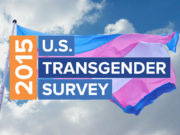There has been quite an uproar over a New York Times piece published last week in which we yet again revisit the ongoing bathroom “debate”, this time with a slight twist: what about locker rooms and other “naked spaces”?
The piece, written by Judith Shulevitz, has received a swift backlash from the transgender community. The Op-Ed has been accused of being sympathetic of transphobic views and is completely void of any consultation or quotes from transgender voices. While much of the criticism has been aimed at omitted voices, there is another, more subtle omission in the discussion, which has become characteristic of any conversation about trans people and nude spaces.
I’m not going to delve into some of the poor choice of words used in these citations (Zack Ford and Chase Strangio have already done that.) Rather, I want to remain focused on the linguistic omissions made by Shulevitz, intentional or not.
Imagine the following scenario. Two teenagers have to change for gym. Both wear the skinny jeans and Converse sneakers that make up the quasi-uniform of the American middle-schooler. But one was born with a girl’s body, the other with a boy’s. The second has asked the school to consider her a girl, and the school has agreed to do so. But the girl-born-a-girl (the cisgender girl, to use the preferred term) does not want to strip in front of the transgender girl or have that person strip in front of her. Meanwhile, the transgender girl does not want to be banished from the common area like some sort of freak. The standoff will end only when one retreats to a stall to change in private. Which one will it be?
So, as Zack already pointed out, buying this narrative only works if we assume that transgender people’s bodies are a “clash of values — gender inclusiveness versus bodily privacy.” But since that has already been decided for us – Shulevitz has the rules set out in this scenario that we are judging these individuals by their appearance – let’s look at that a bit closer.
The descriptions of the two characters in our scenario are incredibly ambiguous. Imagining a cis girl is easy enough, but what about the transgender girl? Is she on hormones? For how long? Does she simply identify as a girl or does she also express as one? Transphobia is often packaged as the story of the predatory “man in a wig”; essentially, a cis, heterosexual man who will do anything to achieve illegal perversions. That narrative is important to maintain in transphobia, because if you put a transwoman who “passes” in their place, you’ve made your transphobic argument substantially more complicated.
“First of all, there is nothing wrong with a person identifying as a woman and expressing outside of traditional female stereotypes. No one needs to ‘pass’.”
First of all, there is nothing wrong with a person identifying as a woman and expressing outside of traditional female stereotypes. No one needs to “pass”. This goes for people who identify as men as well. If you are thinking that none of this should matter, I wholeheartedly agree with you, but I am trying to underline that Shulevitz most certainly hasn’t thought about this or doesn’t care. Her language directs us to come to what, for her, is the key “privacy issue” and the most important conclusion: ‘one was born with a girl’s body, the other with a boy’s.’
So what do they mean by that? It cannot possibly be a question of hairy legs, smaller breasts or no breasts at all. It doesn’t seem to be rooted in minor biological diversity. To the best of my knowledge, a cis girl would be exposed to such physical differences in the nude presence of other cis women. The only possible difference that Shulevitz could be alluding to, but carefully avoids saying, is the existence of an external phallus.

I don’t blame her for avoiding the word. I just did, too. So do a lot of people. In fact, society at large seems very uncomfortable talking about this issue. Even in most of the rebuttals to Shulevitz’s article, there is little mention of what it means, in this context, to be naked.
We are talking about that thing, whatever you want to call it. It is the central point of this argument, and that of many who harbor transphobic sentiment. They are carrying with them a continued externally phallic narrative of the patriarchy, ingrained in the consciousness of western society, that the external phallus is a force to be reckoned with. The external phallus is a danger, a threat to private spaces and to one’s decency. It’s presence, the narrative goes, brings both sexual violence and dominance. Possessing one identifies you immediately as a potential threat.
Some people, often those with transphobic agendas, will make the argument that “you can’t argue with biology”. In this case, I will accord them at least this: yes, all trans women, to my knowledge, are born with an external phallus.
It is not surprising, however, that many trans women do not want to discuss the narrative of the external phallus. A lot of people are understandably not comfortable with talking about something that makes them uneasy.
I’m not going to try and explain what the external phallus means to transgender women. That would be an absurd and impossible undertaking. Having one or having had one is an entirely different experience for each person. There is no authority, no Twitter account, no LGBT organization that can give you a definitive and authoritative account, and neither should there be.
“The truth of the matter is, as pretty much everyone before me has already pointed out, what is between our legs is none of your business.”
The truth of the matter is, as pretty much everyone before me has already pointed out, what is between our legs is none of your business. But access to venues such as saunas, locker rooms and other places where we are naked forces both of us, trans and cis people, to come face to face with a reality: some trans people have slightly different biology than cis people.
The most crucial point that so many of us have been making, repeatedly, is that who we are as people has nothing to do with how we look. We are all women, fat or thin, tall or short, large breasts or no breasts at all. Seeing someone with a different biology to yours should not be a traumatizing experience.
The reason that nudity, or even just the suggestion of it (as is the case with bathrooms, a place where we all take our pants down) seems to remain a traumatizing experience for some, such as Shulevitz’s cis girl, is rooted in something that goes beyond the transphobic. This concept of the phallus as a dominating force has been with us for a long, long time. We are bombarded with this symbolism almost incessantly. You find it in advertising, in art, in jokes about size and power. Look at the recent jokes about Trump and his hands. Funny as it may be, it’s reinforcing this concept that there is somehow a connection to be made.
“People are afraid of trans women, in particular, because there is, following this phallic narrative, the danger of symbolic dominance.”
That concept, inevitably, leads to a second conclusion: anyone possessing an external phallus is inherently in the business of dominance. People are afraid of trans women, in particular, because there is, following this phallic narrative, the danger of symbolic dominance. Look no further than the transphobic language used to demean the presence of trans women: it is an invasion of space, an invasion of privacy, as if trans women were some kind of conquering army seeking to expand their territory.
Shulevitz explains how those invoking Title IX are making this invasion real, suggesting that the presence of a trans girl could constitute the creation of a “hostile environment”. Under the assumption that the trans girl is not prone to more vulgar language than a normal teenager, not engaged in in the practice of selling drugs in the changing rooms or involved in gang warfare, the only possible “hostile environment” that could come about as the result of being naked, which would not occur in the presence of cis girls, is the external phallus.
Title IX does apply to social aspects, where trans women are allegedly invading cis female spaces, but that is a different conversation. Again, trans women are women. Consequently, it is not possible for them to “invade” a “real” woman’s social space.
But not all agree. The possibility of social applications to Title IX, according to Shulevitz, comes from the Women’s Liberation Front, or WoLF, a radical feminist group. Trans exclusionary radical feminists are the flip side of the transphobia coin. While radical Christians fight to maintain God’s plan, trans exclusionary radical feminists seek to ensure that trans women do not muddy the water of progress that feminism has achieved up until now.

This hardline of defining gender, not entirely but in large part, by one’s biology has also been an issue of concern to some lesbian scenes. I remember being stopped at the entrance of a club once, being told by staff “just so you know, this is a lesbian night.” I always find that warning ironic because it was on that “lesbian night” that I met my girlfriend.
If trans women are women (and we are), and we love other women (some of us do), then we are, by definition, lesbians. This fact comes at the price of discomfort for some. To quote Ellen, for the sake of irony, it’s as if I only needed to convince one more lesbian to sleep with me and “I would have gotten that toaster oven”.
I can assure you the trans toaster oven is as mythological as the lesbian one, but they are probably made on the same assembly line.
“The phallic narrative extends beyond transphobia of trans women as well.”
The phallic narrative extends beyond transphobia of trans women as well. Trans men have their own flavor of phallic transphobia to combat with. Some people have tried to argue that trans men “have it better” because other men are not intimidated when they enter a space such as a public restroom or a changing room at a clothing shop.
Again, I am in no position to say what trans men do or do not experience. I would be very interested in their input on this issue.
Cis men, however, have told me on quite a few occasions that they don’t feel intimidated. Often people say something similar to the line “what are they going to do?” which roughly translates to “they can’t assault or rape me.”
One possible reason for this is that cis men, even if they are inclusive of trans men, are still working within the mindset of the patriarchy. That is, trans men don’t have a “real” phallus and, as such, do not pose a “real” threat. Equally so is the possession of a phallus to “qualify” as a “real” man sexually, a problem that persists for gay trans men within LGBT spaces. Some gay cis men maintain that they could not possibly be sexually involved with a trans man because they do not have a “real” phallus, and they are unwilling to accept any alternative to the “real thing”.

The anxiety of this phallic narrative exists outside of LGBT spaces as well. The ongoing “debate” about transphobia is only its latest incarnation.
Anyone possessing an external phallus must obligatorily be in the pursuit of sexual dominance. This can be heterosexual men, gay men, or some trans women.
On the other hand, people have a right to privacy. Courts have largely agreed that no one should have to undress unwillingly in front of a member of the opposite sex, or see that person naked.
Shulevitz insists on referring to trans people as “the opposite sex” here, which either blatantly ignorant or outright transphobic. If a person is a woman, trans or cis, undressing in front of another women, they are not the opposite gender. The only way this quotation can be kept in context is if you are going to insist that the external phallus is the final word on all questions of gender identification.
Call it prudishness, if you like, but such modesty is common. We live in a sex-segregated world. After a certain point in childhood, men and women go their separate ways for almost every activity that involves exposing the body.
I assume Shulevitz is referring to the United States here. She most certainly is not referring to the Western Hemisphere at large. While even the most liberal societies in Europe still struggle with questions of gender identity, a quick visit to Germany or Sweden would provide even the most skeptical critic of gender neutral spaces with working examples. Much of the former GDR (Eastern Germany) continues to practice FKK (being fully naked in public spaces) for the use of public pools, saunas and sunbathing, to name a few spaces. In Stockholm, there are an increasing number of gender neutral bathrooms where each toilet is found in a lockable stall while everyone shares the sink space and mirrors.
Perhaps, however, some of those reading this will find themselves thinking that the above examples do not count, that the difference between European and American culture is simply too different to use such examples. If that is the case, I will conclude by citing Vice President Joe Biden, from a speech he gave to international business leaders in Davos, Switzerland this year: In respect to LGBT rights, the Vice President said: “I’ve had it up to here with culture. I really mean it… Culture never justifies rank, raw, discrimination or violation of human rights. There is no cultural justification. None. None. None”
For everything that I disagree with Shulevitz’s article, I agree with one of her two “future scenarios”:
First, we stop teaching the sexes to hide their bodies from each other. Scientists mostly agree that sexual identity is multifarious, not binary; fungible, not fixed. Sex-linked chromosomes; hormones; the internalization of cultural expectations — all develop differently in each individual, yielding a gamut of sexualities. Perhaps it’s time to retire the notion of two sexes.
It is time to retire the notion, indeed, because it was never real to begin with. As Shulevitz herself points out, there is overwhelming evidence that gender is fluid in biology. The insistence on a false narrative old as time is having a devastating impact on trans people, but that’s not all. It is destroying our ability to have open, progressive dialogue with each other and it continues to be a major source of tension even for cis heterosexuals. The concept of the externally phallic superman continues to drive a gender gap, which has an impact socially and economically.
We must not be afraid to talk about it and, hopefully through dialogue, be willing to change.
































